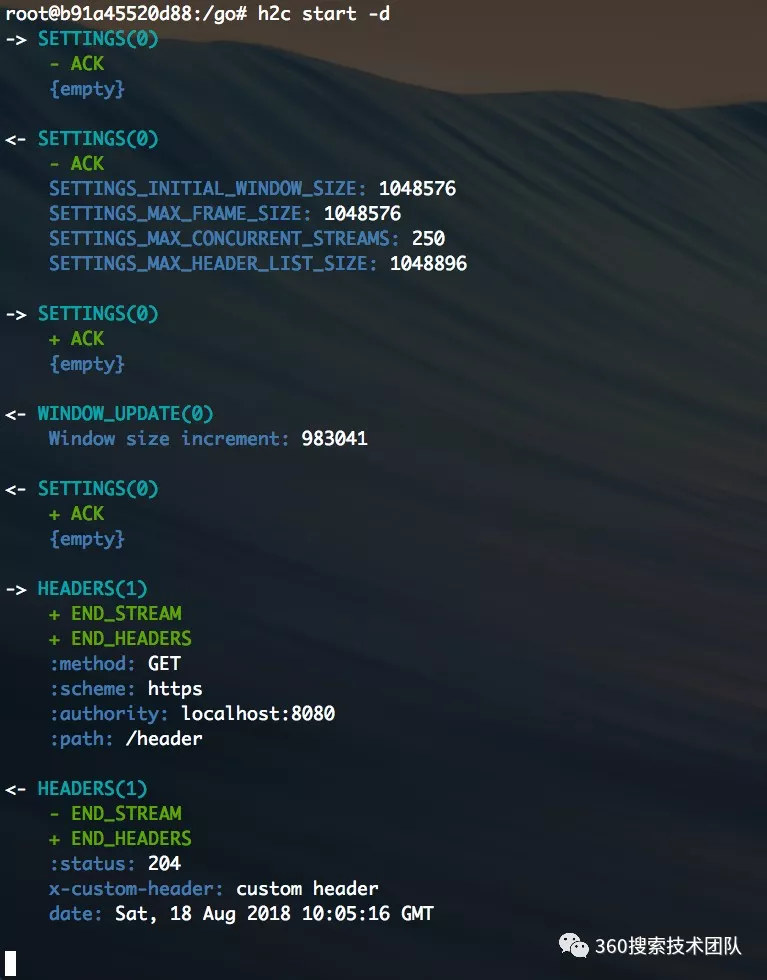本次讲一个非常简单的功能,然后把其内部实现串一下。
这次要实现的功能非常简单,就是一个 http2 的 server,对客户端的请求,只返回一个 header 信息,并且保持连接,以便在后续任何时候进行一些其他的响应操作。目前看起来这个场景可能没有太大作用,其实 HTTP/2 做为一个超文本传输协议,目前我们能想到的应用场景还都是普通的 web 业务,但是老外们的思路就比较广,已经把一些 HTTP/2 的特性在特定的场景发挥出来了,比如 Amazon 的 Alexa,Apple 的 APNS 等。这次实现的这个小功能,就是 Alexa 里用到的一小部分.
Amazon 的 avs(Alexa Voice Service)通过 HTTP/2 实现了全双工的传输功能,其下行功能就用到了这块,Alexa 跟 avs 建立链接后,客户端会发起一个 GET /v20160207/directives 的请求,服务端接受请求后,返回一个 200 的头信息,并 hold 住链接,后续使用该链接通过 Server Push 功能给客户端主动发送指令。
本次开始,我们先不管 Server Push,先从发送 Header 这个小功能开始吧。
HTTP/2 在 GO 语言的实现中没有支持 h2c,所以我们必须使用带证书的加密方式,那么首先需要有一张证书。
我们可以使用 openssl 自己生成一张:
openssl req -newkey rsa:2048 -nodes -keyout server.key -x509 -days 365 -out server.crt
复制代码
然后按提示随便输入一些内容就可以得到两个文件,server.key 和 server.crt,其实就是相当于私钥和公钥。当然这个证书是不能在互联网上正常流通使用的,因为证书是自己签发的,没有人给你做担保,能确认这个证书跟它所标识的内容提供方是匹配的。所以我们在做请求测试的时候,需要客户端忽略证书校验才可以。
服务端 GO 示例的代码如下:
package main
import ( "log" "net/http")
func main() { http.HandleFunc("/header", func(w http.ResponseWriter, r *http.Request) { w.Header().Add("X-custom-header", "custom header") w.WriteHeader(http.StatusNoContent)
if f, ok := w.(http.Flusher); ok { f.Flush() } select {} })
log.Println("start listen on 8080...") log.Fatal(http.ListenAndServeTLS(":8080", "server.crt", "server.key", nil))}
复制代码
服务运行起来后我们在一个较新的支持 HTTP/2 的 curl 命令下执行:
curl "https://localhost:8080/header" -k -i --http2
复制代码
这样就实现了只返回了一个 header 信息,并且链接没有断开。
我们再通过前边介绍过的 h2c 来看下请求的效果:
可以看到返回的只有一个 Header 信息,并且是没有 END_STREAM 标记的。
本次的实践内容到这里就可以结束了,最终实现的代码很简单,但是为什么这样可以实现呢,在缺少相关资料的情况下,很难知道这样做是可以实现该目的的,那么接下来就从 Go 语言中对 HTTP/2 的实现来一探究竟吧:
HTTP/2 Frame in Go
首先来看 HTTP/2 中的最小传输单元:Frame:
// A Frame is the base interface implemented by all frame types.// Callers will generally type-assert the specific frame type:// *HeadersFrame, *SettingsFrame, *WindowUpdateFrame, etc.//// Frames are only valid until the next call to Framer.ReadFrame.type http2Frame interface { Header() http2FrameHeader
// invalidate is called by Framer.ReadFrame to make this // frame's buffers as being invalid, since the subsequent // frame will reuse them. invalidate()}
// A FrameHeader is the 9 byte header of all HTTP/2 frames.//// See http://http2.github.io/http2-spec/#FrameHeadertype http2FrameHeader struct { valid bool // caller can access []byte fields in the Frame
// Type is the 1 byte frame type. There are ten standard frame // types, but extension frame types may be written by WriteRawFrame // and will be returned by ReadFrame (as UnknownFrame). Type http2FrameType
// Flags are the 1 byte of 8 potential bit flags per frame. // They are specific to the frame type. Flags http2Flags
// Length is the length of the frame, not including the 9 byte header. // The maximum size is one byte less than 16MB (uint24), but only // frames up to 16KB are allowed without peer agreement. Length uint32
// StreamID is which stream this frame is for. Certain frames // are not stream-specific, in which case this field is 0. StreamID uint32}
// A FrameType is a registered frame type as defined in// http://http2.github.io/http2-spec/#rfc.section.11.2type http2FrameType uint8
const ( http2FrameData http2FrameType = 0x0 http2FrameHeaders http2FrameType = 0x1 http2FramePriority http2FrameType = 0x2 http2FrameRSTStream http2FrameType = 0x3 http2FrameSettings http2FrameType = 0x4 http2FramePushPromise http2FrameType = 0x5 http2FramePing http2FrameType = 0x6 http2FrameGoAway http2FrameType = 0x7 http2FrameWindowUpdate http2FrameType = 0x8 http2FrameContinuation http2FrameType = 0x9)
复制代码
每个 Frame 都包含一个 http2FrameHeader,这个是每个 Frame 都有的头信息,在 HTTP/2 的定义中如下:
+-----------------------------------------------+ | Length (24) | +---------------+---------------+---------------+ | Type (8) | Flags (8) | +-+-------------+---------------+-------------------------------+ |R| Stream Identifier (31) | +=+=============================================================+ | Frame Payload (0...) ... +---------------------------------------------------------------+
复制代码
能看到其结构分别对应头信息的一些字段。
然后我们以 Headers Frame 为例看下:
// A HeadersFrame is used to open a stream and additionally carries a// header block fragment.type http2HeadersFrame struct { http2FrameHeader
// Priority is set if FlagHeadersPriority is set in the FrameHeader. Priority http2PriorityParam
headerFragBuf []byte // not owned}
// PriorityParam are the stream prioritzation parameters.type http2PriorityParam struct { // StreamDep is a 31-bit stream identifier for the // stream that this stream depends on. Zero means no // dependency. StreamDep uint32
// Exclusive is whether the dependency is exclusive. Exclusive bool
// Weight is the stream's zero-indexed weight. It should be // set together with StreamDep, or neither should be set. Per // the spec, "Add one to the value to obtain a weight between // 1 and 256." Weight uint8}
+---------------+ |Pad Length? (8)| +-+-------------+-----------------------------------------------+ |E| Stream Dependency? (31) | +-+-------------+-----------------------------------------------+ | Weight? (8) | +-+-------------+-----------------------------------------------+ | Header Block Fragment (*) ... +---------------------------------------------------------------+ | Padding (*) ... +---------------------------------------------------------------+
复制代码
http2PriorityParam 表示了 Stream Dependency 和 Weight 信息,headerFragBuf 表示 Header Block Fragment, Padded 信息没有设置单独的结构存储,因为没啥特别的地方会用到,是否存在 Pad 信息放在了 Frame Header 的 Flag 信息里,当 Flags.Has(http2FlagHeadersPadded)时,会取出 Pad 的长度,并在取数据时删减掉。
// Frame-specific FrameHeader flag bits.const ( // ...
// Headers Frame http2FlagHeadersEndStream http2Flags = 0x1 http2FlagHeadersEndHeaders http2Flags = 0x4 http2FlagHeadersPadded http2Flags = 0x8 http2FlagHeadersPriority http2Flags = 0x20
// ...)
// 计算Pad的长度 var padLength uint8 if fh.Flags.Has(http2FlagHeadersPadded) { if p, padLength, err = http2readByte(p); err != nil { return } }
// ...
// 取出 Header Block Fragment hf.headerFragBuf = p[:len(p)-int(padLength)]
复制代码
http2Framer
Frame 的读写操作是通过 http2Framer 来进行的。
// A Framer reads and writes Frames.type http2Framer struct { r io.Reader lastFrame http2Frame errDetail error
lastHeaderStream uint32
maxReadSize uint32 headerBuf [http2frameHeaderLen]byte
getReadBuf func(size uint32) []byte readBuf []byte // cache for default getReadBuf
maxWriteSize uint32 // zero means unlimited; TODO: implement
w io.Writer wbuf []byte
// ....}// http2Framer的操作方法type http2Framer func http2NewFramer(w io.Writer, r io.Reader) *http2Framer func (fr *http2Framer) ErrorDetail() error func (fr *http2Framer) ReadFrame() (http2Frame, error) // ... func (f *http2Framer) WriteData(streamID uint32, endStream bool, data []byte) error // ... func (f *http2Framer) WriteHeaders(p http2HeadersFrameParam) error // ... func (f *http2Framer) WritePushPromise(p http2PushPromiseParam) error func (f *http2Framer) WriteRSTStream(streamID uint32, code http2ErrCode) error // ...
复制代码
可以看到,通过 http2Framer,我们可以很方便的对 http2Frame 进行读写操作,比如 http2Framer.ReadFrame,http2Framer.WritHeaders 等。
http2Framer 是在 http2Server.ServeConn 阶段初始化的:
func (s *http2Server) ServeConn(c net.Conn, opts *http2ServeConnOpts) { baseCtx, cancel := http2serverConnBaseContext(c, opts) defer cancel()
sc := &http2serverConn{ srv: s, hs: opts.baseConfig(), conn: c, baseCtx: baseCtx, remoteAddrStr: c.RemoteAddr().String(), bw: http2newBufferedWriter(c), // ... }
// ...
// 将conn交接给http2Framer进行最小粒度的Frame读写. fr := http2NewFramer(sc.bw, c) fr.ReadMetaHeaders = hpack.NewDecoder(http2initialHeaderTableSize, nil) fr.MaxHeaderListSize = sc.maxHeaderListSize() fr.SetMaxReadFrameSize(s.maxReadFrameSize()) sc.framer = fr}
复制代码
然后在 serve 阶段通过 readFrames()和 writeFrame 进行 Frame 的读写操作。
func (sc *http2serverConn) serve() { // ... go sc.readFrames() // 读取Frame // ... select { case wr := <-sc.wantWriteFrameCh: sc.writeFrame(wr) // 写Frame // ... } // ...}
复制代码
最后还有一点,就是当我们通过调用了 w.Header().Add()方法设置了 Header 之后,如何马上让服务端把这些信息响应到客户端呢,这个时候就是通过 Flush()方法了。
// Optional http.ResponseWriter interfaces implemented.var ( _ CloseNotifier = (*http2responseWriter)(nil) _ Flusher = (*http2responseWriter)(nil) _ http2stringWriter = (*http2responseWriter)(nil))
// ...
func (w *http2responseWriter) Flush() { rws := w.rws if rws == nil { panic("Header called after Handler finished") } if rws.bw.Buffered() > 0 { if err := rws.bw.Flush(); err != nil { // Ignore the error. The frame writer already knows. return } } else { // The bufio.Writer won't call chunkWriter.Write // (writeChunk with zero bytes, so we have to do it // ourselves to force the HTTP response header and/or // final DATA frame (with END_STREAM) to be sent. rws.writeChunk(nil) }}
// ...
func (rws *http2responseWriterState) writeChunk(p []byte) (n int, err error) { if !rws.wroteHeader { rws.writeHeader(200) }
isHeadResp := rws.req.Method == "HEAD" if !rws.sentHeader { // ... err = rws.conn.writeHeaders(rws.stream, &http2writeResHeaders{ streamID: rws.stream.id, httpResCode: rws.status, h: rws.snapHeader, endStream: endStream, contentType: ctype, contentLength: clen, date: date, }) } // ...}
复制代码
通过调用 Flush()方法,由于我们没有设置任何 body 的内容,所以会走到 rws.WriteChunk(nil)逻辑处,这里就是为了在没有内容时,如果希望给客户端响应,来发送 Headers Frame,这里也可以选择在 Header Frame 携带 END_STREAM 来关闭 Stream,这种是我们在 Go 中正常响应 HEAD 请求时的逻辑,如果我们自己通过 Flush 来发送,那么就不会有 END_STREAM,就达到我们的要求了。
ok,至此,整个流程就串起来了。
本文转载自公众号 360 云计算(ID:hulktalk)。
原文链接:
https://mp.weixin.qq.com/s/3IgNBUJpHXKxp6wT6A8EjA











评论